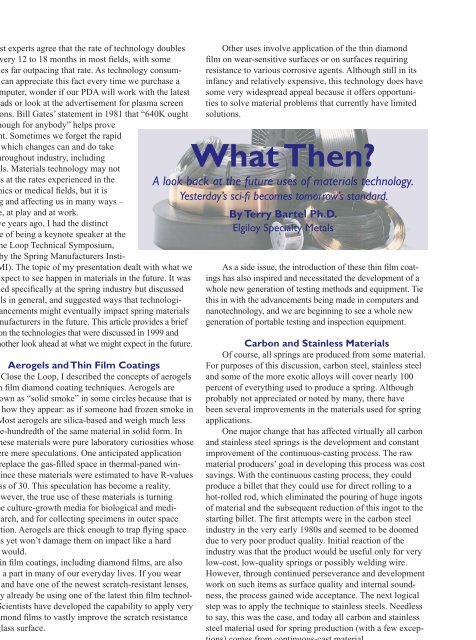Where are Springs Used? - Spring Manufacturers Institute
Where are Springs Used? - Spring Manufacturers Institute
Where are Springs Used? - Spring Manufacturers Institute
Create successful ePaper yourself
Turn your PDF publications into a flip-book with our unique Google optimized e-Paper software.
Most experts agree that the rate of technology doubles<br />
every 12 to 18 months in most fi elds, with some<br />
industries far outpacing that rate. As technology consumers,<br />
we can appreciate this fact every time we purchase a<br />
new computer, wonder if our PDA will work with the latest<br />
downloads or look at the advertisement for plasma screen<br />
televisions. Bill Gates’ statement in 1981 that “640K ought<br />
to be enough for anybody” helps prove<br />
the point. Sometimes we forget the rapid<br />
pace at which changes can and do take<br />
place throughout industry, including<br />
materials. Materials technology may not<br />
progress at the rates experienced in the<br />
electronics or medical fi elds, but it is<br />
growing and affecting us in many ways –<br />
at home, at play and at work.<br />
Five years ago, I had the distinct<br />
pleasure of being a keynote speaker at the<br />
Close the Loop Technical Symposium,<br />
hosted by the <strong>Spring</strong> <strong>Manufacturers</strong> <strong>Institute</strong><br />
(SMI). The topic of my presentation dealt with what we<br />
might expect to see happen in materials in the future. It was<br />
not aimed specifi cally at the spring industry but discussed<br />
materials in general, and suggested ways that technological<br />
advancements might eventually impact spring materials<br />
and manufacturers in the future. This article provides a brief<br />
update on the technologies that were discussed in 1999 and<br />
takes another look ahead at what we might expect in the future.<br />
Aerogels and Thin Film Coatings<br />
At Close the Loop, I described the concepts of aerogels<br />
and thin fi lm diamond coating techniques. Aerogels <strong>are</strong><br />
also known as “solid smoke” in some circles because that is<br />
exactly how they appear: as if someone had frozen smoke in<br />
place. Most aerogels <strong>are</strong> silica-based and weigh much less<br />
than one-hundredth of the same material in solid form. In<br />
1999, these materials were pure laboratory curiosities whose<br />
uses were mere speculations. One anticipated application<br />
was to replace the gas-fi lled space in thermal-paned windows,<br />
since these materials were estimated to have R-values<br />
in excess of 30. This speculation has become a reality.<br />
However, the true use of these materials is turning<br />
out to be culture-growth media for biological and medical<br />
research, and for collecting specimens in outer space<br />
exploration. Aerogels <strong>are</strong> thick enough to trap fl ying space<br />
particles yet won’t damage them on impact like a hard<br />
surface would.<br />
Thin fi lm coatings, including diamond fi lms, <strong>are</strong> also<br />
playing a part in many of our everyday lives. If you wear<br />
glasses and have one of the newest scratch-resistant lenses,<br />
you may already be using one of the latest thin fi lm technologies.<br />
Scientists have developed the capability to apply very<br />
thin diamond fi lms to vastly improve the scratch resistance<br />
of the glass surface.<br />
Other uses involve application of the thin diamond<br />
fi lm on wear-sensitive surfaces or on surfaces requiring<br />
resistance to various corrosive agents. Although still in its<br />
infancy and relatively expensive, this technology does have<br />
some very widespread appeal because it offers opportunities<br />
to solve material problems that currently have limited<br />
solutions.<br />
What Then?<br />
A look back at the future uses of materials technology.<br />
Yesterday’s sci-fi becomes tomorrow’s standard.<br />
By Terry Bartel Ph.D.<br />
Elgiloy Specialty Metals<br />
As a side issue, the introduction of these thin fi lm coatings<br />
has also inspired and necessitated the development of a<br />
whole new generation of testing methods and equipment. Tie<br />
this in with the advancements being made in computers and<br />
nanotechnology, and we <strong>are</strong> beginning to see a whole new<br />
generation of portable testing and inspection equipment.<br />
Carbon and Stainless Materials<br />
Of course, all springs <strong>are</strong> produced from some material.<br />
For purposes of this discussion, carbon steel, stainless steel<br />
and some of the more exotic alloys will cover nearly 100<br />
percent of everything used to produce a spring. Although<br />
probably not appreciated or noted by many, there have<br />
been several improvements in the materials used for spring<br />
applications.<br />
One major change that has affected virtually all carbon<br />
and stainless steel springs is the development and constant<br />
improvement of the continuous-casting process. The raw<br />
material producers’ goal in developing this process was cost<br />
savings. With the continuous casting process, they could<br />
produce a billet that they could use for direct rolling to a<br />
hot-rolled rod, which eliminated the pouring of huge ingots<br />
of material and the subsequent reduction of this ingot to the<br />
starting billet. The fi rst attempts were in the carbon steel<br />
industry in the very early 1980s and seemed to be doomed<br />
due to very poor product quality. Initial reaction of the<br />
industry was that the product would be useful only for very<br />
low-cost, low-quality springs or possibly welding wire.<br />
However, through continued perseverance and development<br />
work on such items as surface quality and internal soundness,<br />
the process gained wide acceptance. The next logical<br />
step was to apply the technique to stainless steels. Needless<br />
to say, this was the case, and today all carbon and stainless<br />
steel material used for spring production (with a few exceptions)<br />
comes from continuous-cast material.<br />
SPRINGS July 2004 21





